
Title means "Quietness", "Comfortable Sound" and "Excellent Acoustics"
Nagata Acoustics News 06-11 (No.227)
Issued :November 25, 2006
Shibuya C.C. Lemon Hall -- Renovated Shibuya Kokaido Reopens with a New Name
by Chiaki Ishiwata
New Facade
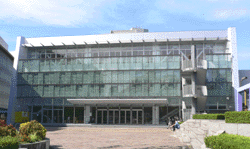 |
After a year of renovation construction that began in autumn, 2005, Tokyo's Shibuya Kokaido, now renamed Shibuya C.C. Lemon Hall reopened on October 1, 2006. With the building's new, glass curtain-wall makeover, passersby may even mistake the renovation for entirely new construction. Soon, the throngs of young people waiting in front of the trendy new entrance to attend their favorite pop stars and bands will be as familiar a sight as it was in front of the pre-renovation building's long-outdated facade. Inside, the foyer now sports a contemporary color scheme and the orange cushion upholstery of the hall's audience seating completes the renovated hall's bright and youthful appearance.
<< A History that Recalls Japan's First Olympic Gold Medal >>
Shibuya Kokaido first opened its doors in 1964, when it served as the Tokyo Olympic weightlifting venue and Yoshinobu Miyake won Japan its first Tokyo Olympic gold medal. According to local historians, construction on the original hall began at the same time that work started on the adjacent Shibuya City Offices administrative structure, and both buildings were scheduled to complete in January, 1965. When the projects were midway towards completion, a decision was made to use the Kokaido as an Olympic venue and the builders rushed to put finishing touches on both the exterior and interior so that the hall could be used for the competitions. Thereafter, the hall officially opened again in 1965.
For some 40 years since its opening, the hall was used frequently for live audience recordings of some of Japan's most popular and long-remembered television programs. "Shibu-Kou" (as the hall's name was affectionately abbreviated) also became known at home and abroad as one of Tokyo's foremost rock and pop concert venues, on a par with Nippon Budokan.
<< Scope of this Renovation Project >>
Meanwhile, for Shibuya Kokaido, as for many halls of the same vintage that have needed repair, Kokaido's required upgrades have included asbestos abatement and seismic improvements, as well as repairing the stage functionality, bringing it up-to-date and, in particular, making many improvements to the stage's safety features. A number of previous renovation projects addressed some of these requirements, and the recently completed project implemented upgrades and changes that could be accomplished within the scope of a one-year effort.
The main changes accomplished in the 2005-2006 project include:
- replacement of the dangerously loose exterior tile facade with a new facade;
- asbestos removal to allow replacement of portions of the hall interior;
- replacement of old and worn stage functionalities and apparatus, including replacing a wooden catwalk and the worn floor surface of the stage; and
- installation of new audience seating, including increasing the width of each seat from 450 mm. (18 in.) to 500 mm. (19 in.) (resulting in a reduction of the total number of seats from 2,318 to 2,084).
In connection with these improvements, the project also replaced the proscenium loudspeakers and the registers that are visible in the hall at the ends of ventilation ducts. An additional change certain to draw a nostalgic sigh from readers familiar with Japanese TV of the late 20th century is the removal of the revolving stage. The variety show "It's 8 p.m.! Everyone's Time to Get Together," which aired weekly on Japanese network TV, every Saturday night from 1969 to 1985, recorded its broadcasts at Shibuya Kokaido and constantly used the revolving stage in its skits. In recent years, however, the revolving stage was used, at most, a handful of times per year.
Nihon Sekkei, Inc. was responsible for the renovation project's design and construction management. Nagata Acoustics served as the Acoustical Consultant for the hall interior's room acoustical design, design of the stage sound system and related implementation activities.
<< Acoustical Approach for the Hall's Interior Renovations >>
View from audience area
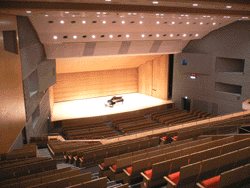 |
|
|
Interior of Shibuya C.C.Lemon Hall
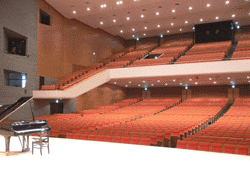 |
|
This project's renovations to the hall's interior included replacing the surfaces of the ceiling, the sidewalls (except for tiled portions of the walls toward the front of the hall), the rear wall and the acoustical reflection panels. As the client did not have specific acoustical objectives for the renovation project, we began our work by surveying the existing characteristics of the room acoustic and studying the hall's original drawings and, because major structural modifications were outside the construction scope, we decided to focus attention on ensuring that the renovations preserve the pre-renovation state of the hall's acoustics, which already had a favorable reputation.
The originally designed height of Shibuya Kokaido's proscenium opening and the room's overall spatial volume lack the size of more recently built multipurpose halls, and even an article written around the time that the hall was built mentions that overall building height restrictions limited the height of the hall's ceiling. But the hall shape does have acoustical merit and, in particular, the original designer's efforts to create good acoustics are evidenced in the ceiling's distribution of early sound reflections ubiquitously throughout the hall. The acoustics are appropriate when the event program is an award or other ceremony, lecture or, especially, the kind of popular music concerts using electric instruments that were constantly scheduled at Shibuya Kokaido and will be the mainstay of Shibuya C.C. Lemon Hall.
Another acoustically good aspect of the hall's interior design is the sufficiently high height of the distance from the floor of the audience seating to the underside of the balcony overhang in relationship to the depth of the first floor seating area from the balcony edge to the rear wall. While it is typical for halls built in the same era to have an abundance of sound absorbing surfaces in their interiors, this hall only had sound absorbing surfaces installed on the rear wall and rear-half of the underside of the balcony. In addition, the hall's original specifications called for a layer of linoleum to be sandwiched between the main ceiling's layers of board, apparently recognizing the need to control the absorption of low frequency sound to by damping vibration of the ceiling boards.
As part of the 2005-2006 project's renovations, the shape of the ceiling changed from using curved surfaces to sections with sharp, straight lines. In making this modification, Nagata Acoustics maintained the ubiquitous distribution of early sound reflections throughout the entire audience seating area. Keeping in mind the project's budget and other factors, we selected three layers of 15 mm. (0.6 in.) gypsum board for the renovation's ceiling material.
Regarding the movable acoustical shell on the stage, before the current renovations began, ceiling panel of the shell, which were suspended from the ceiling, did not have embedded lighting. Instead, the panels were spaced with wide gaps between them so that the stage lighting would shine through the gaps and panels and lighting equipment could be used at the same time. As part of this renovation, at the request of the hall's lighting technicians we embedded the lighting fixtures in the ceiling panels of the acoustical shell and minimized the spaces between the panels. Unfortunately, we were not able to address the existing large gap between the proscenium opening of the stage and the set of the acoustical shell, because a comprehensive overhaul of the placement of the stage machinery and equipment was beyond the scope of the project.
After the completion of the renovations, our acoustical measurements found that when configured with a stage curtain the hall's reverberation time of 1.0 seconds (at 500 Hz) remained unchanged. When the hall is configured with the acoustical shell, the hall now has a reverberation time of 1.2 seconds, which is 0.1 seconds longer than before the renovations, making the reverberation time difference between the two configurations greater than it was previously.
<< Naming Rights - A New Phenomenon in Japan >>
When the renovated hall opened recently, newspapers and other Japanese media made much ado about the name change to Shibuya C.C. Lemon Hall. The change was effected by the sale of the hall's "naming rights," an arrangement not yet commonplace in Japan for publicly funded buildings. Nagata Acoustics participated in another project, the Oita Prefectural Cultural Center, which entered into a naming rights agreement with the distiller of the popular Japanese Iichiko-brand "shochu" liquor, and the hall now bears the name Iichiko Cultural Center.
At a live recording made in celebration of the re-opening of the hall, the mayor of Shibuya Ward mentioned that the contract under which the hall is named Shibuya C.C. Lemon Hall will bring 80 million yen (532 thousand euros, US$679 thousand) per annum to Shibuya Ward's coffers, and will last for five years. The substantial value of the hall's naming rights surely points to the hall's established reputation as a successful concert venue.
The 2005-2006 renovation project cannot be said to have touched every part of the hall that could benefit from a facelift. In particular, the dressing rooms and backstage area remain unchanged and in need of refurbishing. Daily inconveniences remain in running the hall, and these are overcome by the efforts and dedication of the hall personnel who sustain the hall. Now that funds will come from the naming rights contract, I hope that meaningful use will be made of the available monies to complete the remaining needed improvements to the hall's facilities and to keep charm of its own.
Photographs by H.Fukunishi (Nihon Sekkei, Inc.)
Suntory Hall at Age 20 - Three Reasons that Make this Hall a Success
by Dr. Minoru Nagata, Founder of Nagata Acoustics
On October 12, 1986, the late Keizo Saji, Suntory President, stood at the keyboard of the new hall's pipe organ and struck the A note, signaling the opening of Suntory Hall. With the birth of Suntory Hall, Japan's classical music world took a great stride forward. Suntory Hall and the other major new halls that followed in its wake earned prominence and respect internationally as well as at home. As one of the participants in the project to design and construct Suntory Hall, and as a music lover, I will take this opportunity to remark on three of the hall's successes.
1. Suntory Hall brought the vineyard configuration into the mainstream of concert hall design, and contributed significantly to this configuration gaining adherents and advocates throughout the world.
From the post-World War II era to the 1980s, cities such as Tokyo developed unquenched thirsts for classical music concert halls. At the time, the sole ideal concert hall to emulate was Vienna's Musikverein. This hall has the configuration commonly known as the "shoebox" shape. The shoebox configuration also held sway among academic experts in the field, who focused on the acoustically desirable propagation of lateral sound reflections in rectangular spaces of narrow width.
Into this setting of actively used, historically venerated halls, the radical idea was conceived of configuring a hall with stepped balcony sections placed so that their front wall surfaces would produce early sound reflections, and in 1963 a new hall came into being with a configuration based on this novel concept. This was the hall named, simply, Neue Philharmonie. It was located in West Berlin and was to serve as the home hall of the Berlin Philharmonic under the baton of Maestro Herbert von Karajan. However, perhaps because the distinctive orchestral style Maestro Karajan developed in this hall took precedence among critics, the uniquely shaped hall's reputation did not flourish as might have been hoped. Using the hall evaluation method proposed by Dr. Leo Beranek, one of the world's leading acousticians, Neue Philharmonie Hall did not attain the highest possible rating. Nevertheless, Mr. Saji enjoyed a friendship with Maestro Karajan and he decided to take the Maestro's advice and make Suntory Hall Japan's first vineyard configuration concert hall.
In the early days after Suntory Hall's opening, when local Tokyo orchestras performed in the new hall, they evaluated it using the halls they knew as their frame of reference, and the halls they knew, such as Tokyo Bunka Kaikan, all had stages surrounded by sound-reflecting surfaces. As a result, the local orchestras' first impressions of Suntory Hall were less than stellar. By contrast, the Berlin Philharmonic Orchestra and the Vienna Philharmonic Orchestra gave Suntory Hall glowing reviews, as did other European and U.S. orchestras that performed there. After Suntory Hall pioneered the vineyard configuration in Japan, the Sapporo Concert Hall project followed suit with a vineyard configuration, giving both domestic and overseas orchestras more opportunities to experience playing in vineyard configuration halls. As audiences and performers grew accustomed to the sound these halls produce and the unique way that, in these halls, each sound seems to take flight and circulate in splendid and brilliant choreography, a taste for the vineyard configuration has became established in Japan and around the world.
Among Nagata Acoustics most recent projects, the 2003 opening of Walt Disney Concert Hall of course represents another successful vineyard configuration concert hall project. In addition, our projects in Copenhagen, Helsinki, Hamburg, Paris (for Radio France) and Shenzhen are all large-scale concert halls being designed with vineyard configurations.
2. Suntory Hall took the lead in Japan in creating variety-filled concert programming and artistically scripted, stimulating productions.
A hall's character and classiness is most tellingly revealed in the concerts and programs that the hall sponsors and produces. Suntory Hall welcomes the world's leading orchestras, ensembles and soloists all year long. For me, the pinnacle event is the annual black-tie gala concert held each October in celebration of the hall's anniversary. This year, for the 20th anniversary, the gala concert featured "The Three Great Tenors" Neil Shicoff, Giuseppe Sabbatini and Vincenzo La Scola, giving the gala concert an unusually strong opera focus. Suntory Hall already has an established and well-known annual "hall opera" production, separate from the gala concert. For my individual taste, I equally enjoyed the gala concerts of past years that combined classical music performances with the wit of Tetsuko Kuroyanagi as mistress of ceremonies and a sampling of traditional Japanese dance forms, ballet performances and cameo appearances of other traditional performing arts genres. For many of the opera fans who attend the Suntory Hall gala concert, I suspect that this year's gala concert was especially satisfying.
Another Suntory Hall program I especially enjoy is the Small Hall's "Saturday Salon," held on a handful of Saturday afternoons each year. This year's "Saturday Salon" brought Prof. Tatsuo Minagawa (Rikkyo University Professor Emeritus) to the Small Hall for talks by the professor on his encyclopedic knowledge of classical music and European culture. The program included both a sophisticated lecture and a chamber concert, with the luxury of sipping wine during the intermission, transporting me away from the world outside to enjoy the moment of a truly refined and stimulating Saturday afternoon.
3. Suntory Hall set new standards of customer service for concert patrons.
Nowadays, Japanese concert hall goers assume that a concert hall has a reception desk where they can ask questions and get assistance. This approach to interacting with concert patrons started when Suntory Hall opened and Mr. Saji recognized the need to put in place a high standard of customer service. With the opening of Suntory Hall, the roles of usher, cloak attendant and other customer facing hall personnel became trained hall employee positions instead of part-time workers hired temporarily for each concert or event. Today's hall personnel provide courteous and knowledgeable customer service to assist patrons with everything from unanticipated minor (and not-so-minor) emergencies to answering questions about the artists and the concert program.
Another customer service change that Suntory Hall pioneered in Japan was to offer varied and delicious refreshments before concerts and during intermissions. Suntory Hall was the first concert hall in Japan to add beer, wine and champagne to the menu of soft drinks, coffee and tea served at publicly funded concert halls. Moreover, the customer service extended by the wait staff of the hall set new standards of hospitality for concert hall refreshment services. I give high marks to Suntory Hall for the way it treats concert hall patrons and its high level of customer service.
In the above paragraphs I reviewed three pillars of success that Suntory Hall has given to Japan's classical music community. These three pillars are the acoustical design plans for the hall, hall-sponsored programming and a high standard of customer service to concert patrons. As the world of classical music continues to evolve, I look forward to watching Suntory Hall continue to be a trendsetter and a leader in excellent concert hall management.
Kauffman Center for the Performing Arts Breaks Ground
by Dr. Yasuhisa Toyota
On October 6, 2006, in Kansas City, Missouri, the ground-breaking ceremony was held for the Kauffman Center for the Performing Arts (KCPA). When completed, the KCPA will include three main facilities: a 1,600-seat classical music concert hall; an 1,800-seat proscenium theater primarily intended for ballet and opera performances; and, a multi-use Celebration Hall space capable of holding seats for up to 400.
The project's funding comes from the locally-based Muriel McBrien Kauffman Foundation and from many other donations. The total budget is US$ 326 million (253 million euro), including a US$40 million (31 million euro) operating endowment.
The project has assembled a design team of noted, internationally active professionals. The architect is Boston-based Moshe Safdie of Moshe Safdie and Associates and the theater designer is Richard Pilbrow, founder of Theatre Projects Consultants. Nagata Acoustics joined the project team in the summer of 2003 in the role of chief acoustician, with responsibility for the room acoustical design of the two main halls as well as for the entire center's acoustical design.
The project is scheduled to complete in 2009. The concert hall will become the home hall of the Kansas City Symphony. The proscenium theater will have two resident performing arts companies, the Kansas City Ballet and the Lyric Opera of Kansas City.
Nagata Acoustics' next milestone activity is acoustical testing in the 1/10 scale model, which we will conduct from December, 2006 through March, 2007. The recently completed scale model is shown in the accompanying photograph. In a future article in this newsletter I look forward to introducing more details about the scale model testing and the progress of the overall project.
Exterior
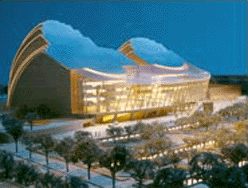 |
|
| | | | | |
Scale Model for Concert Hall
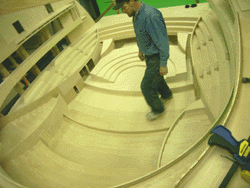 |
|
E-mail Distribution of Nagata Acoustics News & Opinions
We hope you have enjoyed this News & Opinions newsletter, available each month on our web-site (http://www.nagata.co.jp). We also offer e-mail delivery of the text version of this newsletter. To receive the text newsletter to your e-mail address, simply send the following information to us at newsmail_e@nagata.co.jp:
(1) Your e-mail address
(2) Your name
(3) The name of your company
By requesting the text version via e-mail, you will automatically receive every newsletter and you can still get the visuals and graphics at our web-site.
Nagata Acoustics News 06-11 (No.227)
Issued : November 25, 2006
Nagata Acoustics Inc.
Hongo Segawa Bldg. 3F, 2-35-10
Hongo, Bunkyo-ku, Tokyo 113-0033 Japan
Tel: +81-3-5800-2671, Fax: +81-3-5800-2672
(US Office)
2130 Sawtelle Blvd., Suite 307A,
Los Angeles, CA 90025, U.S.A.
Telephone: (310) 231-7818
Fax: (310) 231-7816
E-mail: info@nagata.co.jp



